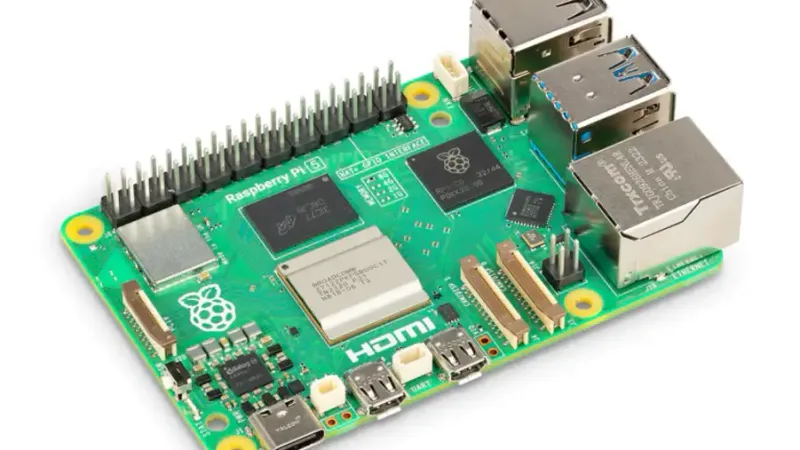Meet the new Raspberry Pi 5
The Raspberry Pi Foundation just released their latest innovation, the Raspberry Pi 5.
The new iteration features groundbreaking silicon at its heart. The Raspberry Pi 5 is a game-changer with a few new tricks up its sleeve.
The Raspberry Pi Foundation has navigated countless challenges over the years, from production woes to supply chain disruptions. But their unwavering commitment to delivering computing innovation to all has brought us to this pivotal moment.
Introducing the Raspberry Pi 5: A Marvel of Custom Silicon
The Raspberry Pi 5 is based on the Broadcom BCM2712, which houses a quad-core 2.4GHz 64-bit Arm® Cortex®-A76 processor. However, the standout component here is the RP1, a proprietary I/O controller crafted entirely in-house by the Raspberry Pi team. This custom chip assumes a pivotal role in furnishing USB 3.0, Ethernet, GPIO, MIPI display, and MIPI camera ports. The inclusion of the RP1 custom I/O chip not only adds stability to the Pi 5's manufacturing process but also optimizes power consumption by integrating only the most critical circuits into the chip.
But the excitement doesn't stop there. Beyond custom silicon, the Raspberry Pi 5 introduces a four-lane PCIe 2.0 interface, streamlining high-speed peripheral connections. It also boasts Bluetooth® 5.0 with Bluetooth Low Energy, dual-band Wi-Fi®, and Gigabit Ethernet, granting users the flexibility to choose between wired and wireless connectivity. Moreover, the Pi 5 extends support for Power over Ethernet (PoE), enabling users to power the board via Ethernet, alongside a USB Type-C port for alternative power sources.
While the board seamlessly integrates a real-time clock (RTC), the absence of an onboard battery necessitates using a networked time server to maintain time accuracy during power disruptions. Fortunately, users can power the RTC externally through a supercapacitor or small battery, ensuring precise timekeeping even in power outage scenarios.
Power management receives an upgrade with the Renesas DA9091 power management IC, capable of supplying up to 20A to the BCM2712 for high-performance processing. The PMIC and Raspberry Pi 27W power supply should reduce or eliminate power warnings in most scenarios.
Raspberry Pi 5 Specifications
Broadcom BCM2712 2.4GHz quad-core 64-bit Arm Cortex-A76 CPU featuring cryptography extensions, 512KB per-core L2 caches, and a 2MB shared L3 cache.
VideoCore VII GPU, supporting OpenGL ES 3.1, Vulkan 1.2
Dual 4Kp60 HDMI display output with HDR support
4Kp60 HEVC decoder
LPDDR4X-4267 SDRAM (4GB and 8GB available at launch)
Dual-band 802.11ac Wi-Fi
Bluetooth 5.0/Bluetooth Low Energy
microSD card slot, with support for high-speed SDR104 mode
2 × USB 3.0 ports, supporting simultaneous 5Gbps operation
2 × USB 2.0 ports
Gigabit Ethernet, with PoE+ support (requires separate PoE+ HAT)
2 × 4-lane MIPI camera/display transceivers
PCIe 2.0 x1 interface for fast peripherals (requires separate M.2 HAT or other adapter)
5V/5A DC power via USB Type-C, with Power Delivery support
Raspberry Pi standard 40-pin header
Real-time clock, powered from external battery
Power button
Conclusion
The introduction of the Raspberry Pi 5 heralds yet another innovation from the Raspberry Pi Foundation. The inclusion of the RP1 custom I/O chip not only adds stability to the Pi 5's manufacturing process but also optimizes power consumption by integrating only the most critical circuits into the chip.
You can pre-order the Raspberry Pi 5, from Mouser here.
Note: This article was written by Mouser staff using OpenAI ChatGPT v4.

